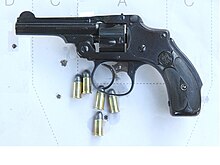Smith & Wesson double action break-open revolver
The revolvers of the Smith & Wesson Double Action break-barrel revolvers in calibers .44, .38 S&W and .32 were further developments of the Smith & Wesson No 3 and had a cocked trigger .
history
In 1872 Smith & Wesson developed a "Double Action" revolver, which was then called "Self-Cocking" (self-cocking). This model was a further development of model No. 3, which was offered to Tsarist Russia at the time (see Smith & Wesson No 3 "Russian Model"), but was not ordered.
The commercial introduction of the "Double Action" revolver on the American market did not take place until after 1880; after it was determined that sales of the Colt Double Action Revolver Model 1877 and 1878 had declined. S&W started the market launch with a smaller model in calibers .38 and .32. The design was classic on the model No. 3 ajar, the frame and barrel could be tipped forward for loading and the gun, like all models common at the time, had an external hammer. This development was to become one of the most popular weapons; by the time production was discontinued in 1919, 941,119 of these revolvers had been produced.
"Hammerless Model"
From 1886 Smith & Wesson brought the "New Departure Safety Model" onto the market, a "hammerless", that is to say, a tapless version of this revolver. The cock was completely integrated into the frame and no longer visible from the outside. The weapon could only be fired by pulling the trigger (Double Action Only). Another safety feature of this weapon was a mechanism built into the handle, which only unlocked the hammer when the grip was strong and firm. This model was built until 1940.
The successor model with a swiveling drum came onto the market in 1952 and was produced until 1974. These weapons, called Centennial Model 40 and 42 , also made use of the same mechanics adapted to the frame as the original "Hammerless Model".
Trivia
D. B. Wesson is said to have learned of the fate of a child who was seriously injured while handling a revolver. Thereupon he developed a "child-safe" model with the mechanics described above, which, due to the effort required, only allowed an adult to fire a shot with this weapon.
literature
- Norm Flayderman: Flayderman's Guide to Antique American Firearms . Krause Publications, Iola WI 2001, ISBN 0-87349-313-3 .
- Roy G. Jinks: Smith & Wesson, a company with a history . Stocker-Schmid, Dietikon-Zurich 1979, ISBN 3-7276-7025-8 .
Web links
- Alpha Catalog 1911: S & W Kipplaufrevolver (variants, details and sales price in Marks (1911)), since 160, archive.org .



